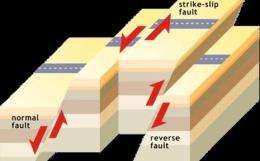What Happened in Haiti?

(PhysOrg.com) -- As the world focuses on the heart-wrenching losses and unbelievable devastation of the recent earthquake in Haiti, researchers at Michigan Technological University, discuss what happened there and why.
“Every disaster situation is different,” says Bill Rose, professor of petrology in the geological and mining engineering and sciences department. “Haiti sits on a major strike-slip fault, where one side moves one way, and one moves another.”
“The Caribbean plate is moving eastward relative to the North American plate,” explains Wayne Pennington, professor and chair of the department.
“In Hispaniola, the island containing Haiti and the Dominican Republic, the plates are further split into one or two little plate slivers, with a northern boundary near the northern shore of the island and a southern boundary along what is called the Enriquillo fault.” Pennington says. “It is this southern fault that ruptured during the earthquake. Stress had been building up here since the last large earthquake along that fault, in 1751.”
“As geologists, we think in different time-frames,” Rose says. “An occurrence of every 200-plus years is not long, when we talk in terms of millions of years.”
The fault is actually similar to the San Andreas Fault in California, Rose says. And one unique characteristic of quakes like this is that they may occur in “timed clusters” where, when one part releases, others close by may follow.
“El Salvador had a major quake in 2001 and a second quake one month later was actually worse than the first,” Rose says.
Following Haiti’s quake, the same fault could release within the Dominican Republic to the east or perhaps in Jamaica to the west, says Rose. Another fault going through the island nation could release in Cuba. Any of these events could happen “soon.”
It has also been reported that the quake was a shallow one. The rupture of the Enriquillo fault began only eight miles (13 kilometers) below the surface, and that, too, has immense ramifications, according John Lyons, a PhD candidate in geology.
“Shallow earthquakes transfer substantially more energy to the surface than do deep quakes. This translates into more violent ground motion capable of producing the damage we are seeing across Haiti.” he says.
In addition to the lack of depth and high magnitude, which was 7.0, the type of earthquake is also important, both Rose and Lyons say. The earthquake in Haiti occurred at a strike-slip fault, which has a different motion than a subduction zone fault, where tectonic plates collide, sending one over the other. The latter "can lift or lower a huge volume of water, generating a tsunami” Lyons says. A recent example was the devastating Sumatran earthquake in 2004.
The need for research is now, the geologists agree.
“We need to do geological fieldwork,” Rose says, “to measure where the fault is and where it has moved or not moved.
“In the past couple of decades, there had been some debate about whether or not we should expect an earthquake along that fault,” Pennington notes. “But modern GPS measurements have demonstrated that the stress has been accumulating, and scientists published a paper in 2008 showing that a magnitude 7.2 event could be expected there at any time.”
He added that earthquake prediction has not yet shown precisely when, where, and how large an earthquake is expected.
“But we do know which areas, in general, are more hazardous than others, and this earthquake, as tragic as it is, was not unexpected. The same is true of many areas. In some parts of the world, preparation for large earthquakes is standard practice.”
In California, for example, Pennington says that building standards are strictly enforced, and civil defense authorities have stockpiled supplies to be used if necessary. “Communication procedures are practiced for use in disasters, and the people have at least a general notion of what to do in the case of a large seismic event,” he says. And earthquake drills have been organized in each of the past two years.
“All of these seismic-safety practices are absent in Haiti,” he says, “where widespread disregard for whatever building codes may exist resulted in unstable structures that crumbled during the shaking. A lack of infrastructure that could survive the earthquake resulted in the chaos we now see hampering the rescue effort.”
Of course, the initial requirement for the international aid community is to save lives and relieve the massive suffering being experienced by the Haitian people, Pennington adds.
“But, within a few weeks, the task of rebuilding or recovery will begin,” he says. “As in many cases, a serious effort will be made to ‘build back better’ and incorporate practices of infrastructure development that can be sustained by the local population and will prove safer in the future. The goal will be to create resilient communities: ones that can survive and bounce back from disasters or other shocks to the system.”
It will not be easy.
“For generations, Haitians have suffered from lack of opportunity,” Pennington says. “In addition to building ‘things’—roads, buildings, water treatment and supply systems—it will be necessary to build an economic system that can provide ongoing support for maintenance, and education for the people who will provide that maintenance. This is our next challenge.”
Provided by Michigan Technological University
















